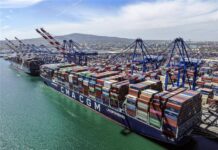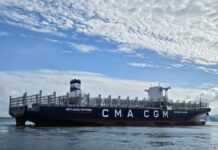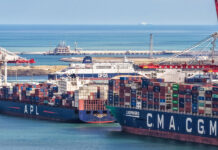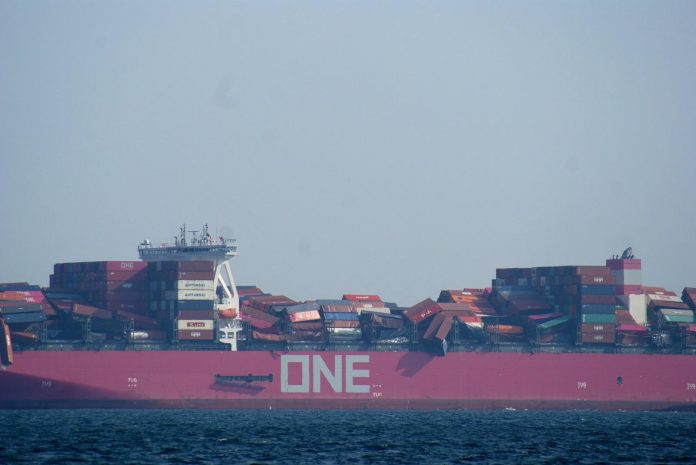
Over the last three months more than 3,000 containers have been lost or damaged due to stack collapses on vessels operating in the Pacific trades, investigations into the losses are ongoing, but there are suggestions from some in the industry that the vessels are overloaded.
[s2If is_user_logged_in()]Demand in the US has increased substantially over the second half of 2020 with a shortage of containers and, initially at least, a shortage in vessel capacity as carriers sought to match space to demand.
With the increased demand came the pressure from shippers to move cargo from Asia to the US sending rates spiralling upwards as a result. As the pressure increased to ship goods and the profits soared the carriers have been keen to load as much cargo as they can from Asia with vessels sailing at 90% plus utilisation levels, and cargo being increasingly rolled over, according to data from Ocean Insights.
Some industry experts are beginning to question the reasons behind the spate of accidents that began in early November with the ONE Aquila losing more than 100 containers overboard in a storm, through the major losses suffered by ONE Aquila’s sister ship ONE Apus, which lost around 25% of its volume overboard through to the latest major event with the Maersk Essen losing around 750 boxes, again in heavy weather in the Pacific.
There have been a number of other smaller events in that time also, some that were never reported on, but mostly the vessels were travelling from Asia to the US, loaded with cargo.
One senior industry source told Container News, “This is a Covid issue,” the source who had seen the video of the Maersk Essen on Container News before Maersk demanded that WK Webster remove the footage from its website and retract permissions for media to show the images, believes that economic pressure is seeing carriers load as many containers as possible in Asia, overloading stacks which ISO stipulates should be 7-9 high.
In fact, the ISO standard 1496-1 stipulates, “Fully loaded containers must be capable of nine high stacking. This is a stacking weight of 192,000kg on the bottom container, equivalent to eight containers – each of 24,000kg and an acceleration force of 1.8G – stacked on top of the container.”
Images of the Maersk Essen with containers stacked 10 high showed that the carriers could be overloading the stacks, though there is no clarity on the total weights of those boxes. And as a master mariner and consultant pointed out, Maersk is not the only carrier to have stacked boxes 10 high either. The recent accident involving the Ever Liberal clearly shows the vessel with boxes ten high on deck. Though the severity of the Evergreen ship’s losses were considerably less, having only seen 36 boxes lost.
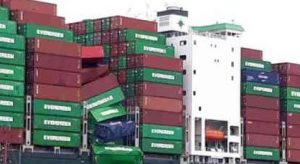
The master mariner concluded that it was too simplistic to suggest that stacking boxes ten high was the cause of the accidents, and that while there was substantial pressure to load more cargo, vessels are loaded using computer technology and the stack weights are automatically calculated and they would not exceed the maximum weights.
Perhaps surprisingly the North of England P&I club states in its literature on container stacking, “There appears to be no requirement for container manufacturers to comply with the ISO standard.”
Container weights themselves, as shown by the introduction of the verified gross mass (VGM) regulation in July 2016, can be a moveable feast.
VGM requires a shipper to declare the weight of each container, either through the weighing of the container itself when loaded, or through the calculation of the weight of the contents plus the unloaded weight of the container.
However, as the master mariner concedes the shipper is required by regulation to declare the weight, but many shippers could misdeclare the actual weight in documents, leaving the port and master none the wiser to the actual weight of a container.
Should the stack weights be miscalculated or misdeclared the weight on the bottom box in a stack may exceed its maximum design force. That in itself could cause the container to collapse bringing the boxes on top down but also having a domino effect on the adjacent stacks.
Maersk is investigating the losses from the Maersk Essen, the company confirmed, “Maersk is analysing any event of failure on employed lashing systems and has a continuous improvement system in place to minimise the risk of similar incidents occurring in the future.”
One of the issues that may be looked at in that investigation, aside from the actual weights of containers, is the lashing mechanisms. The master mariner points out that container stacks have three different forces acting on them when a ship is in motion. The static force, which is downward pressure caused by the weight of the containers in the stack.
Then there are dynamic forces which he describes as “like standing on a bus, holding onto a steadying post.” When the bus turns a corner you the force on your arm increases. This is similar to the forces on the lashing rods applied to a container stack.
The third force is a lashing force, and this works on the lashing bars which are connected to a number of containers, symmetrically, that is the same lashing configuration on the port and starboard sides. As the ship rolls the stack moves with the lashing bars holding the container stack. These forces can be excessive and lead to a stack collapse from the bottom up.
“This applies to all incidents where container stack losses have occurred,” said the master.
Effectively, the master explains, “If you consider the ship looking from stern to bow is a like a circus tent, when the ship rolls to starboard the tent pegs [lashing rods] on the port side take the force and the force on the starboard side is relaxed.”
This creates two competing forces, a horizontal force parallel to the main deck, and the other a vertical force parallel to the centreline.
“These two forces create a downward force on the container stack and imposes an additional compressive force on the container posts, that is additional to the static force when the vessel is upright,” said the expert, adding that, “no-one can calculate that additional compressive force.”
Furthermore, class rules on stack loads only account for a vessel roll of 2-15degs, there is no clarity on the forces applied to a stack if the vessel rolls to angles than 15degs.
Maersk told Container News, “There are several possible failure modes and sequence of failures of a lashed container stack. The lashing rods are generally applied symmetrically to the containers so in general, there is no issue with the rods contributing to uneven loads.”
In fact, this may be incorrect. There could well be a significant issue with the lashing rods, but the solution may not be innovative engineering, it could come from another vessel sector.
Cruise ship customers do not feel comfortable with the rolling of a ship. These vessels are fitted with dynamic stabilisers to mitigate the rolling motion. These stabilisers can be retracted when coming into port or passing other vessels.
“Containers don’t usually care about rolling motions and dynamic stabilisers are expensive to fit, so the container carriers have not considered them in the past,” said the master mariner. He believes it is time for the carriers to take another look.
Nick Savvides
Managing Editor
[/s2If]
[s2If !is_user_logged_in()]Please login or register to read the rest of the story[/s2If]


